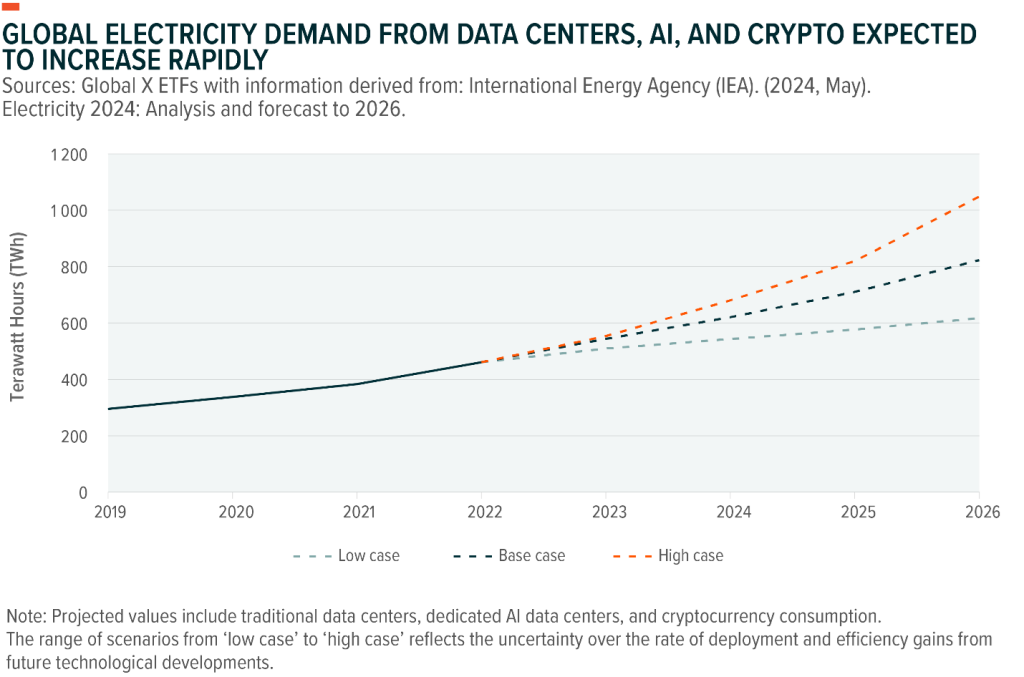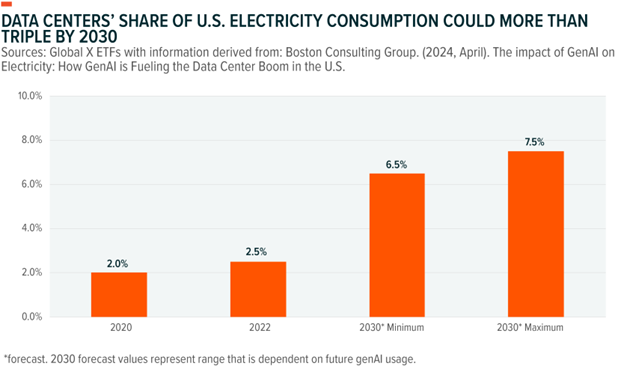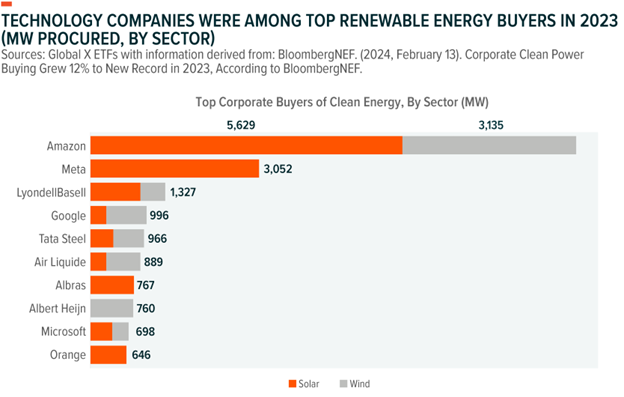Authored by Global X Research Team
As artificial intelligence (AI) continues to advance at a rapid pace, it’s increasingly clear that reliable and resilient power sources and infrastructure are critical to its growth. Highlighting the urgency is the International Energy Agency’s (IEA) estimate that by 2026 electricity demand from dedicated AI data centers could grow by more than 10x from 2023 levels.1 In line to benefit from this new demand source over the long term are companies throughout the power sector, in particular companies across the renewable energy value chain and those that provide the required power infrastructure and equipment.
Key Takeaways
- AI and data centers will likely require tens of gigawatts of additional power generation capacity around the world over the next several years, and companies are ramping up spending to secure more power.2
- While all types of power sources could benefit from the increased demand, renewable energy systems such as wind and solar power can help tech companies meet their power needs while also making progress towards sustainability goals.
- On recent earnings calls, management from companies throughout the renewable energy industry emphasized data centers and AI as key growth avenues.
Rapid Growth of AI and Data Centers Has Increased Power Demand Forecasts
Generative AI systems such as ChatGPT are rapidly evolving, and companies are working to significantly expand data center capacity to keep pace with the AI revolution. Jensen Huang, CEO of AI chipmaker NVIDIA, expects that companies could spend a hefty $1 trillion over the next four years to upgrade and expand data center infrastructure to meet the growing demand from AI applications.3
Not only is the number of data centers rising, but they’re also getting bigger and requiring more power. On its Q1 2024 earnings call, Virginia-based utility Dominion Energy reported that requests for energy demand from proposed data center campuses range from 300 megawatts (MW) up to several gigawatts (GW).4 The current generation of data centers typically require only about 30MW of electricity demand, while individual data centers under development request as much as 90MW.5 Also, the AI data center racks that are used in training models can use 5–7x more energy than traditional data center racks.6
The subsequent increase in power demand is likely to create significant new growth opportunities for power producers around the world. In particular, the IEA forecasts that electricity consumed by data centers and cryptocurrencies around the world could increase from 460 terawatt-hours (TWh) in 2022 to as high as 1,050 TWh in 2026.7 For context, this type of demand would be roughly equal to Germany’s current electricity needs.8 At the country level, Ireland’s rapidly expanding data center landscape could account for one-third of the country’s electricity demand by 2026. China’s data center electricity demand could grow 1.5x from 2020 levels to reach 300 TWh by 2026.9 In Canada, electricity demand is forecast to jump to 1,300 TWh by 2050, according to PwC. Executives at companies such as Ballard Power Systems and Cameco are eyeing AI-powered energy opportunities too.

In the United States, the largest data center market in the world, data center electricity consumption could more than triple from 126TWh in 2022 to 390TWh by the end of the decade.10 As a result, by 2030, data centers could account for 7.5% of U.S. electricity consumption, up from an estimated 2.5% share in 2022.11 Combined with rising adoption of electric vehicles (EVs) and the ongoing electrification of industrial activities, total U.S. electricity demand is forecast to increase by as much as 20% by the end of the decade.12 This growth would be quite the U-turn from the near-flat U.S. power demand growth over the last decade.13,14
Recently, U.S. utilities began discussing plans to account for additional growth. For example, Georgia Power has increased its projected load growth from around 400MW in their plan from January 2022 to more than 6,600MW in their plan from October 2023.15 That’s a 16.5x increase in forecasted demand growth in under 2 years. Dominion Energy forecasted demand from data centers in Virginia to more than double from 3.3GW in 2023 to more than 7GW in 2030.16 That said, the company’s recent requests for “several gigawatts” from data center developers suggest the potential for even more demand growth.

Renewables Can Help Meet Added Demand Without Compromising Companies’ Sustainability Targets
Data centers are likely to create growth opportunities for a range of power sources, including natural gas, nuclear power, wind power, solar power, hydrogen, and energy storage systems. In particular, renewable energy systems may help meet the AI-induced power demand while also keeping companies on track towards their clean energy targets. Microsoft aims to match 100% of its electricity consumption to zero-carbon energy sources, 100% of the time, by 2030.17 Google pledged to power its operations with carbon-free energy 24/7 by 2030, and Meta also committed to reaching net zero emissions across its value chain by the end of the decade.18,19
Tech giants and AI leaders like Microsoft, Google, and Meta are already top clean energy buyers, and in our view, they’re likely to remain top customers as they look to secure even more clean power for AI operations.20 For example, in May 2024, Microsoft and Brookfield Renewable Partners announced a corporate power purchase agreement (PPA) for the development of 10.5GW of wind and solar power capacity in the United States and Europe between 2026 and 2030. The agreement is about 8x larger than the previous largest corporate PPA, and it is estimated that the total wind and solar project costs could exceed $10 billion.21,22 The two companies have also discussed expanding the deal to include more projects and other countries.23 In December 2023, Meta announced a PPA with renewables developer Ørsted for a 300MW solar farm and a 300MW, 4-hour battery energy storage system to power its data center operations in Mesa, Arizona.24 In addition to renewables, companies like OpenAI and Amazon are exploring potential opportunities to use nuclear power for more sustainable data center operations.25

The Clean Energy Buyers Association (CEBA), which counts Google, Meta, Amazon, and Microsoft as members, is also working with utilities to ensure that renewables remain a part of the conversation as they come up with resource plans to meet forecasted demand growth. For example, in April 2024, CEBA and Georgia Power announced plans to work together to develop a new customer clean energy program that will be included in the utility’s 2025 Integrated Resource Plan (IRP) filing.26 IRPs are planning documents that outline how utilities expect to meet forecasted future power demand. Prior to this announcement, Georgia Power had been planning to expand fossil fuel-fired power plant capacity to meet expected demand growth from tech and industrial customers.27 The collaborative efforts with CEBA open up the opportunity for renewables to potentially be a bigger part of the solution.
Management Commentary Highlights AI-Induced Growth Opportunities for the Power Sector
On recent earnings calls, management teams from companies across the renewable energy value chain highlighted the potential growth opportunities from the adoption of AI. Connor Teskey, CEO of Brookfield Renewable Partners, stated that the market is only just starting to understand the amount of power needed for the adoption of AI, and that “sourcing sustainable renewable power at scale is now on the critical path to delivering the rollout of AI globally.”28Kirk Crews, Executive VP and CFO of NextEra Energy, reported that strong demand for the company’s power is partly due to industrial customers looking to decarbonize operations and meet AI and data center demand.29 Mark Widmar, CEO of solar panel equipment provider First Solar, noted that data center load growth is partly responsible for increased demand expectations.30
The AI industry also recognizes that significant power growth is central to support future advancements. Ami Badani, CMO of chip designer Arm Holdings, stated that AI’s “insatiable demand” for electricity means that advancements in AI can’t continue without addressing the growing power needs.31 Badani also noted that a single ChatGPT query requires 15x more energy than a typical web search.32
Conclusion: AI’s Impact on the Renewables and Power Sectors Could Be Substantial
OpenAI CEO Sam Altman recently admitted that “we still don’t appreciate the energy needs of this technology.”33 What can be said with more certainty at this point is that for the AI revolution to take hold, more power is needed. For investors looking for potential clues about the connection between AI’s proliferation and potential opportunities in energy, we believe that big tech being among the most prolific buyers and supporters of clean energy is meaningful. In our view, this type of demand and its potential impact on the ongoing energy transition creates significant long-term opportunities for renewable energy producers and equipment providers.
Related ETFs
Click the fund name above to view current performance and holdings. Holdings are subject to change. Current and future holdings are subject to risk.
Sources
1 International Energy Agency (IEA). (2024, May). Electricity 2024: Analysis and forecast to 2026.
2 Ibid.
3 Data Center Dynamics. (2024, February 14). Nvidia CEO Jensen Huang predicts data center spend will double to $2 trillion.
4 Dominion Energy. (2024, May 2). Q1 2024 Earnings Call [Presentation].
5 The Motley Fool. (2024, May 2). Dominion Energy (D) Q1 2024 Earnings Call Transcript.
6 S&P Global. (2023, October 17). Power of AI: Surging data center load has Dominion bracing for AI’s added demand.
7 International Energy Agency (IEA). (2024, May). Electricity 2024: Analysis and forecast to 2026.
8 Ibid.
9 Ibid.
10 CPower. (2024, March 19). Demand Growth Offers Opportunities for Data Centers.
11 Ibid.
12 CNBC. (2024, May 5). AI could drive a natural gas boom as power companies face surging electricity demand.
13 EIA. (n.d.). Electric Power Monthly: Table 5.1. Sales of Electricity to Ultimate customers. Accessed on May 17, 2024.
14 Wood Mackenzie. (2024, March 1). Demand growth creates new challenges for the power industry.
15 Georgia Power. (2023, October 27). Company seeks approval to invest in and deploy new generation resources, continue transforming its fleet and electric grid.
16 CNBC. (2024, May 5). AI could drive a natural gas boom as power companies face surging electricity demand.
17 Brookfield Renewable Partners. (2024, May 1). Brookfield and Microsoft Collaborating to Deliver Over 10.5 GW of New Renewable Power Capacity Globally.
18 Google Sustainability. (n.d.). Operating on 24/7 Carbon-Free Energy by 2030. Accessed on May 15, 2024.
19 Meta Sustainability. (n.d.). Climate. Accessed on May 15, 2024.
20 BloombergNEF. (2024, February 13). Corporate Clean Power Buying Grew 12% to New Record in 2023, According to BloombergNEF.
21 Brookfield Renewable Partners. (2024, May 1). Brookfield and Microsoft Collaborating to Deliver Over 10.5 GW of New Renewable Power Capacity Globally.
22 CNBC. (2024, May 1). Microsoft signs deal to invest more than $10 billion on renewable energy capacity to power data centers.
23 Brookfield Renewable Partners. (2024, May 1). Brookfield and Microsoft Collaborating to Deliver Over 10.5 GW of New Renewable Power Capacity Globally.
24 Ørsted. (2023, December 11). Meta and SRP customers will benefit from the solar and stored energy from Eleven Mile Solar Center in Pinal County.
25 NBC News. (2024, March 4). The AI industry is pushing a nuclear power revival – partly to fuel itself.
26 Clean Energy Buyers Association (CEBA). (2024, April 16). CEBA Agreement with Georgia Power Opens Path To Customer-Driven Clean Energy.
27 Canary Media. (2024, April 22). Data centers want clean electricity. Can Georgia Power deliver it?
28 The Motley Fool. (2024, May 3). Brookfield Renewable Partners (BEP) Q1 2024 Earnings Call Transcript.
29 The Motley Fool. (2024, January 25). NextEra Energy (NEE) Q4 2023 Earnings Call Transcript.
30 The Motley Fool. (2024, May 1). First Solar (FSLR) Q1 2024 Earnings Call Transcript.
31 Fortune. (2024, April 16). AI could gobble up a quarter of all electricity in the U.S. by 2030 if it doesn’t break its energy addiction, says Arm Holdings exec.
32 Fortune. (2024, April 22). OpenAI’s Sam Altman is funding a green-energy moonshot as AI’s power demand grow to ‘insatiable’ levels.
33 The Verge. (2024, January 19). Sam Altman says the future of AI depends on breakthroughs in clean energy.
DISCLAIMERS
Commissions, management fees, and expenses all may be associated with an investment in products (the “Global X Funds”) managed by Global X Investments Canada Inc. The Global X Funds are not guaranteed, their values change frequently and past performance may not be repeated. Certain Global X Funds may have exposure to leveraged investment techniques that magnify gains and losses which may result in greater volatility in value and could be subject to aggressive investment risk and price volatility risk. Such risks are described in the prospectus. The Global X Money Market Funds are not covered by the Canada Deposit Insurance Corporation, the Federal Deposit Insurance Corporation, or any other government deposit insurer. There can be no assurances that the money market fund will be able to maintain its net asset value per security at a constant amount or that the full amount of your investment in the Funds will be returned to you. Past performance may not be repeated. The prospectus contains important detailed information about the Global X Funds. Please read the relevant prospectus before investing.
Certain ETFs are alternative investment funds (“Alternative ETFs”) within the meaning of the National Instrument 81-102 Investment Funds (“NI 81-102”) and are permitted to use strategies generally prohibited by conventional mutual funds, such as the ability to invest more than 10% of their net asset value in securities of a single issuer, the ability to borrow cash, to short sell beyond the limits prescribed for conventional mutual funds and to employ leverage of up to 300% of net asset value. While these strategies will only be used in accordance with the investment objectives and strategies of the Alternative ETFs, during certain market conditions they may accelerate the risk that an investment in ETF Shares of such Alternative ETF decreases in value. The Alternative ETFs will comply with all requirements of NI 81-102, as such requirements may be modified by exemptive relief obtained on behalf of the ETF.
Certain statements may constitute a forward-looking statement, including those identified by the expression “expect” and similar expressions (including grammatical variations thereof). The forward-looking statements are not historical facts but reflect the author’s current expectations regarding future results or events. These forward-looking statements are subject to a number of risks and uncertainties that could cause actual results or events to differ materially from current expectations. These and other factors should be considered carefully and readers should not place undue reliance on such forward-looking statements. These forward-looking statements are made as of the date hereof and the authors do not undertake to update any forward-looking statement that is contained herein, whether as a result of new information, future events or otherwise, unless required by applicable law.
This communication is intended for informational purposes only and does not constitute an offer to sell or the solicitation of an offer to purchase investment products (the “Global X Funds”) managed by Global X Investments Canada Inc. and is not, and should not be construed as, investment, tax, legal or accounting advice, and should not be relied upon in that regard. Individuals should seek the advice of professionals, as appropriate, regarding any particular investment. Investors should consult their professional advisors prior to implementing any changes to their investment strategies. These investments may not be suitable to the circumstances of an investor.
All comments, opinions and views expressed are generally based on information available as of the date of publication and should not be considered as advice to purchase or to sell mentioned securities. Before making any investment decision, please consult your investment advisor or advisors.
Global X Investments Canada Inc. (“Global X”) is a wholly owned subsidiary of Mirae Asset Global Investments Co., Ltd. (“Mirae Asset”), the Korea-based asset management entity of Mirae Asset Financial Group. Global X is a corporation existing under the laws of Canada and is the manager, investment manager and trustee of the Global X Funds.
Published June 18, 2024
